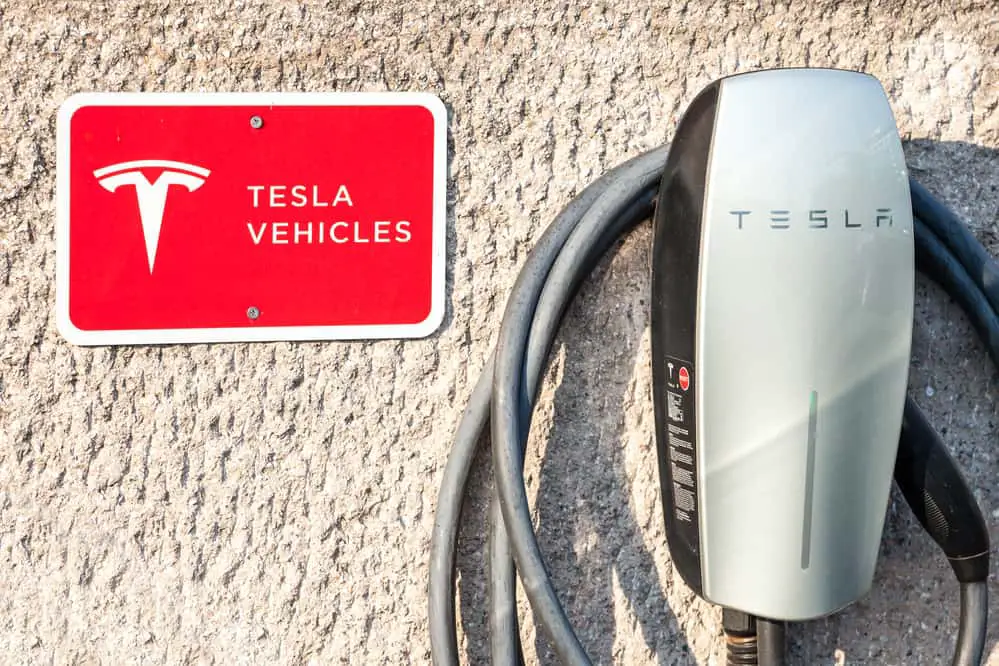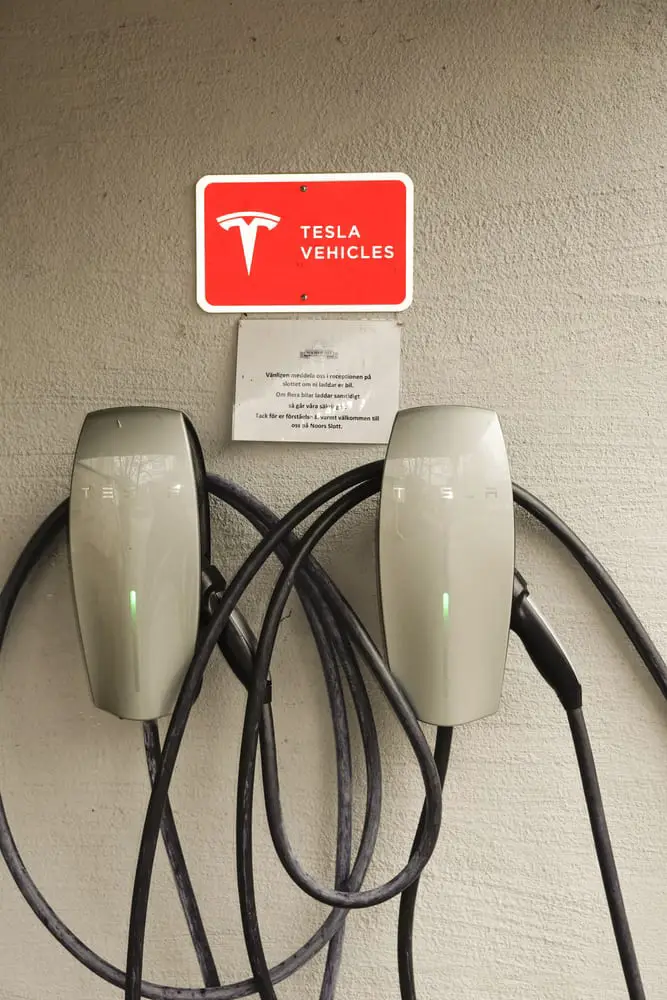As more and more people switch to electric vehicles, the demand for convenient charging solutions becomes increasingly important. One such solution that Tesla offers is the Tesla Wall Charger.
However, homeowners and commercial establishments might be curious if this advanced charging option can be installed outdoors.
After all, an outdoor installation could potentially prove to be more convenient for certain property layouts while also allowing for sharing amongst multiple users.
Tesla Wall Charger Overview
The Tesla Wall Charger, also known as the Tesla Wall Connector, is a level 2 charger designed for efficient and convenient home charging of Tesla electric vehicles. It offers faster charging speeds compared to the standard mobile connector and comes with several advanced features.
Features and Specifications
- Power Output: The Tesla Wall Charger provides up to 11.5 kW of power, ensuring a quicker charging time for your Tesla vehicle.
- Cord Length: The Wall Connector comes with a 12 or 18 feet cable, depending on your preference, allowing for flexibility in charger placement and vehicle parking.
- Wi-Fi Connectivity: The Tesla Wall Charger supports over-the-air firmware updates via Wi-Fi, which enables the charger to receive improvements and new features.
- Load Sharing: When you have multiple Tesla Wall Connectors on the same electrical circuit, load sharing allows them to allocate the available power between the charging vehicles effectively.
- 240 Volt: The Wall Connector utilizes a 240-volt AC supply for efficient charging.
- Warranty: The Tesla Wall Charger comes with a 4-year warranty, offering peace of mind for quality and performance.
Compatibility with Tesla Models
The Tesla Wall Charger is compatible with all Tesla models available on the market, including the Model S, Model 3, Model X, and Model Y. It is important to note that charging speeds will vary based on the battery type and vehicle model.
Additionally, the Tesla Wall Connector can be integrated with the Tesla Powerwall, supporting the seamless use of solar electricity generated by solar panels. This way, you can efficiently charge your Tesla vehicle using clean and renewable energy while reducing your dependence on grid electricity.
Installation Process
Hiring a Professional Electrician
When installing a Tesla wall charger outside, it’s essential to hire a professional electrician to handle the process. They can ensure the installation is done safely and meets the charging requirements for your electric vehicle.
As charging stations involve high-voltage electrical systems, licensed electricians are capable of properly assessing your garage and main panel for compatibility. They can also recommend the best installation location to provide both convenience and protection for the charger.
Permits and Legal Requirements
It is necessary to comply with the permits and legal requirements in your area, particularly if you live in a state like California with stricter regulations.
Before starting the installation process, check with your local authorities to determine if a permit is required for installing a Tesla wall charger outside your home. This process may involve submitting documentation, conducting inspections, and paying fees.
To prevent any fines or legal complications, always adhere to the permit requirements and guidelines specified by your local government. Additionally, ensure that your electrician is familiar with the rules and regulations in your area.
Setting Up the Wall Charger
Selecting the Right Installation Location
When installing a Tesla wall charger outside for your electric vehicle, it’s important to choose the right location. The charger should be close to where you park your vehicle and have easy access to your electrical panel. The installation area should be well-lit, safe, and protected from inclement weather, such as heavy rain or snow.
If possible, it’s advantageous to install the charger near a 240-volt outlet, like a NEMA 14-50, to optimize charging speed. Also, ensure that the surrounding area is free of obstructions and potential hazards for both the vehicle and the charger.
Preparing the Electrical Panel and Wiring
To prepare your home’s electrical panel for the Tesla wall charger, you may need to upgrade to a higher-capacity panel (if not already equipped) to handle the additional load. Ensure that the electrical panel has a dedicated circuit breaker for the charger and that it complies with relevant safety regulations.
For the wiring process, you typically have two options: hardwiring the charger directly or using a NEMA 14-50 plug and outlet (like this). Hardwiring offers a more seamless appearance but may require professional assistance to ensure it’s done safely and correctly.
The NEMA 14-50 plug and outlet option allows for easier installation and charging flexibility, as you can use the charger with a J1772 connector for other electric vehicles if needed.
Keep in mind that installation costs will vary depending on factors such as location, local regulations, and accessibility to your electrical panel. It’s essential to do thorough research and obtain quotes from multiple professionals when setting up your Tesla wall charger for charging at home.
Quick Comparison:
| Option | Pros | Cons |
|---|---|---|
| Hardwiring | Seamless appearance | May require professional assistance |
| NEMA 14-50 Plug & Outlet | Easier installation and flexibility | Slightly less aesthetic |
As electric vehicle technology and infrastructure continue to evolve, having a home charging station like the Tesla wall charger offers long-term convenience and reliability for electric vehicle owners in North America.
Taking the time and effort to properly select the right installation location and prepare your electrical panel and wiring is crucial to make the most out of your electric vehicle charging experience.
Using and Maintaining the Tesla Wall Charger
Controlling Access with the Tesla App
The Tesla App is the primary tool for controlling access to your Tesla Wall Charger. With the app, you can set charging schedules, limit charging amperage, and monitor usage statistics.
The app works seamlessly with your Tesla vehicle and any integrated solar system, allowing you to manage your energy consumption effectively. To control access, simply navigate to your charger settings within the app and adjust access permissions as needed.
Updating Firmware and Connectivity
A Tesla Wall Charger is WiFi-enabled and includes automatic firmware updates to ensure its optimal performance. To update the firmware, connect your Wall Charger to your home WiFi network. The charger will automatically receive updates when available, ensuring that your device is always up-to-date with the latest features and improvements.
If you encounter any issues with your Tesla Wall Charger, the support section in the Tesla app contains helpful FAQs and contact information. Additionally, Qmerit has partnered with Tesla to provide professional installation services and assist with any technical difficulties.
To fully benefit from the Tesla Wall Charger, it’s essential to maintain a robust hardwired connection with the appropriate amperage. This will allow you to achieve the best possible charging range for your vehicle.
For some users, integrating Tesla Powerwalls into their solar system can help optimize their charging experience and manage their energy consumption more efficiently.
Pros and Cons of Installing a Tesla Wall Charger Outside
One of the main pros of installing a Tesla wall charger outside is the convenience it provides. It allows you to charge your electric vehicle (EV) in a location that may be more accessible and closer to where your vehicle is parked.
This is especially helpful if you do not have a garage or covered area to install the charger. Additionally, the charging speed will not be affected whether the wall charger is inside or outside, allowing you to retain fast charging times.
Outdoor wall chargers are also designed to withstand various weather conditions, including rain. Tesla’s wall chargers have a robust structure and materials, ensuring that the electrical systems inside are protected from moisture and other external elements. This makes them suitable for installation outside without compromising their functionality.
However, there are also some cons to consider when installing a Tesla wall charger outside. One major concern is the potential exposure to harsh weather conditions other than rain, such as extreme cold or heat, which may have an impact on the charger’s performance and lifespan.
Furthermore, outdoor chargers could be more prone to damage from external factors, such as accidents or vandalism.
Another drawback is the increased risk of electrical hazards, especially in wet conditions.
While Tesla wall chargers are designed to be safe, there is always a minimal risk of electrical malfunctions when the charger is installed in an uncovered outdoor area. This makes it extremely important to have the charger professionally installed and to follow the necessary precautions.




